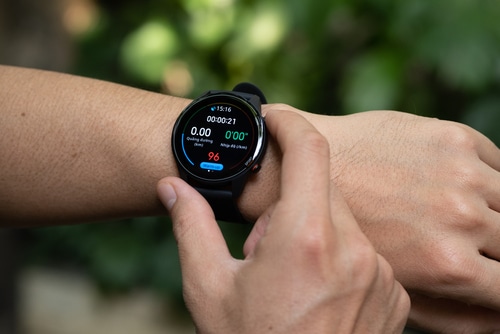Budget priced smart watches are among fast selling gadgets today. Some of the most interesting functions of smart watches make them highly loved digital goods and hence they have a huge following today. If you are keen to buy an affordable smart watch, the two top selling choices you can consider are the Xiaomi Mi Watch and Huawei Watch GT 2e. In fact, we can say these two models are the best options in the budget smart watch segment right now.
Their budget prices do not permit that luxury and hence they cannot fit into the definition of the perfect smart watch. Nevertheless, they can satisfy many robust expectations of the users and can deliver great designs and a list of very useful features. Here I have discussed how Xiaomi Mi Watch compares with Huawei Watch GT 2e covering their features, specifications and functions to guide your decision between these two.
Xiaomi vs Huawei Smartwatch
Check out the Mi Watch on Aliexpress
Check out the Huawei Watch GT on Aliexpress
Xiaomi Vs Huawei Review – My Opinion
Truth be told, Huawei has a bit of a negative reputation since they got banned by the US Government. But they’ve still been able to make a name for themselves. My honest opinion is, Huawei makes the best hardware for their devices in the Android ecosystem. The Huawei products I’ve purchased on Aliexpress have always been solid.
Having said that I will still prefer to go with Xiaomi’s smartwatches as their ecosystem is bigger and they can build better software and connect to the Google Play Store.
Design
Both these smart watches have worn circular looks. The overall appearance will let anyone feel that they must have cost more.

The Huawei Watch GT 2e is touted as a sporty choice among the range of Huawei’s GT 2e. The 46mm case of this smart watch model is made from plastic and metal and are rendered in clack or stainless steel finish. Without the strap, the watch weighs 43 grams with a thickness of 10.8mm.

The Mi Watch is slightly smaller in size measuring 45mm and the difference is not noticeable. The weight is however lighter than Huawei Watch GT 2e at 32g. The thickness of Mi Watch is 11.8mm. Mi provides this smart watch in four colors including black, red, green and white.
The looks of both these models are great. Huawei has incorporated some extra details on the bezel, while Xiaomi has chosen to keep it simple.
Xiaomi Mi watch is a lighter option and you might not favor the GT 2e if you are concerned about its heaviness.
Drawing inspiration from the sporty bands of Apple, Huawei has fitted its smart watch with TPU or fluroelastomer strap. Xiaomi has resorted to the basic design for the strap using a TPU band with a simple pin.
Display
Talking of display in both these smart watches, the screens are of top quality. You can set Mi’s 1.39-inch, 454 x 454 AMOLED display always on. Huawei’s offering also has this feature on its 1.39-inch, 454 x 454 AMOLED display. Therefore with regard to the viewing angles and quality, you are almost getting the same.
Huawei’s screen looks a bit sharper while the Xiaomi’s colors are more vibrant. Nevertheless, both these screens are good.
In addition to giving a touchscreen model, both these makers have given physical buttons on the sides of their smart watches. The operations of both these watches are almost similar. Upon landing on the home screen, you have shortcut to track the workouts.
Both these watches have 5ATM water resistance rating and hence it is possible to take them to a depth of 50 meters under water.
Health and fitness tracking features
Since both these watches are primarily designed for exercise, they do provide some excellent sensors and features to accommodate some robust fitness tracking functions.
In the Huawei Watch GT 2e, there is a GPS, motion sensor of the kind you find in sports watches, and an optical heart rate monitor. These sensors are made for 24/7 monitoring of activity, sleep, and SpO2 levels. For sports tracking, this model has 85 workout modes such as treadmill running, regular running, cycling, swimming in open water, swimming in pool and indoor rowing. Runners can benefit from the guided running sessions irrespective of whether you are attempting interval running newly or would try your first 5K. This watch also features training effect and recovery and VO2 Max insights ably supported by Firstbeat, the heart beat analytics outfit.
The fitness tracking features of Mi smart watch are optical heart rate monitoring, GPS with a wide satellite coverage, Gallileo, BDS support to map the outdoor activities, and Glonass. The device’s gyroscope motion sensors and accelerometer can track the indoor activities. There is also a compass and air pressure sensor. This smart watch can count the steps, heart rate, stress levels and sleep round the clock besides finding out the blood oxygen measurements. Mi offers the same kind of insights powered by Firstbeat. In addition, it also provides an energy feature that functions in the same way like Garmin’s Body Battery Monitor which examines the activity, sleep, and heart rate measurements to let you know how equipped are you to take your day.
Sports tracking features
In the sports tracking segment, the Xiaomi offers about 117 workout modes. The 17 core workout modes of the watch can provide richer and more activity-oriented metrics. The GT 2e offers 90 sports modes and six of them come with automatic exercise recognition feature.
Talking of fitness tracking, they have similar functions. When it is the question of activity tracking, their functions are pretty basic aiming at motivating you to go a bit more ahead. Huawei’s sleep tracking is more accurate with more useful insights and reports about sleep. Huawei’s smart watch also has some highly accurate functions for heart rate and stress monitoring, and general health monitoring.
In tracking sports, the accuracy on both the devices is almost the same. However, the Huawei UI weighs on the positive side for the reviewing stats and the running guides. In both these devices many users say the heart rate tracking for high intensity exercise is not up to the mark and hence this needs to be remedied by using an external chest strap monitor.
With regard to data sharing, Huawei enables data sharing on Apple Health and Google Fit. With the entry of third party developers, Huawei can probably improve this segment significantly in the coming years.
Smart watch features
Both these smart watches are compatible with Android and iOS devices. Nevertheless, the GT 2e promises a highly comprehensive experience while clubbed with an Android phone. On the other hand, the Xiaomi assures an equal support across both Android and iOS devices. Hence, those who are looking forward to use their smart watch with an iOS device, Xiaomi offers a better choice.
Huawei Watch GT 2e provides the basic notifications, a remote smartphone camera shutter mode, a plethora of watch faces, controls for music playback, a built-in music player for Android phones and a 4GB storage. You can view weather forecasts and set alarms on this watch.
Excepting the music player, the Mi Watch also does majority of these things. In addition, an interesting feature of this model is the smart assistant Amazon Alexa that can work on Bluetooth connection on your phone.
Battery life
On both these smart watches, you can expect the power to last for two full days on a single charge.
420mAh battery in the Xiaomi Mi Watch can last for 16 days in the normal usage mode, 22 days in the long battery usage mode and 50 hours of power on GPS mode. Also, it is important to note that these modes depend on which features you use regularly as different features impact the battery life differently.
The main reason for Huawei to dump WearOS is to give way to more battery life and hence you can certainly expect this from the GT 2e. The device features 455mAh battery that can assure two weeks of battery life.
When put on heavy usage test, the Huawei battery seems to last for longer thanks to the weight of the features that it has got to power. The Mi watch also assures a two week long battery life with solid activities.
While the results put both these watches on the same rank with regard to battery life, if you would expect more in this segment, it is better to choose Huawei.
Conclusion
While both the Huawei Watch GT 2 and the Xiaomi Mi Watch are highly impressive models available in the budget priced smart watches segment today, the question is now which one is a better pick among the two.
Sporting similar screens, features, and sensors, these two smart watches can create the same kind of first impact in the viewers. The characteristics that make Xiaomi stand out are its lighter design, highly encouraging GPS battery numbers and the smart watch features such as Amazon Alexa, which are not available on the Huawei model.
With regard to sporty looks, activity, health and sports monitoring features, GT 2e is on part with Mi. What you find extra in the Huawei smart watch are some additional functions that can benefit beginners. This segment talk in favor of the Huawei model. Most smart watch features are similar between both these models. Android phone users get to enjoy the addition of the music player. The ability to share data with other apps can get better in both these phones with the launch of some new watch apps. The battery life is also equally encouraging with both the models.
Both these smart watch models have their own advantages and disadvantages. Irrespective of which one you will choose, you are going to land on a great buy for the price you pay since they carry affordable price tags. Hence the choice can be based on your personal preferences with nothing much to gain or lose while going for one.
Xiaomi vs Huawei Fitness Tracker
Page Contents
